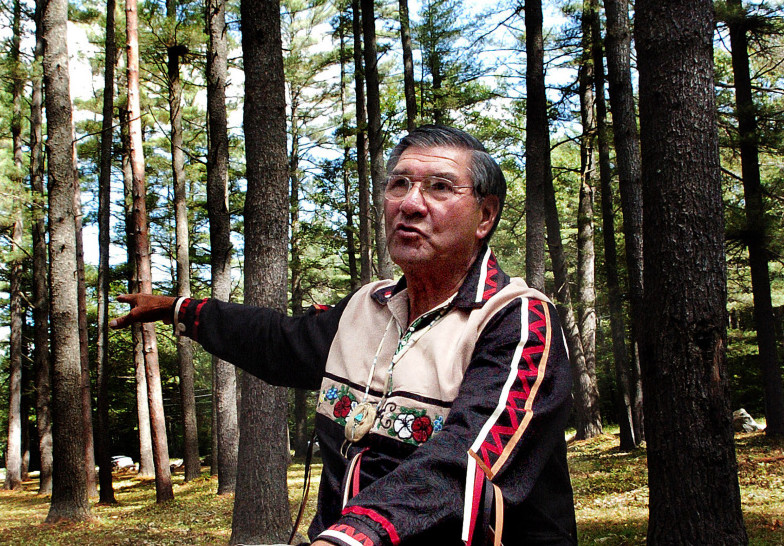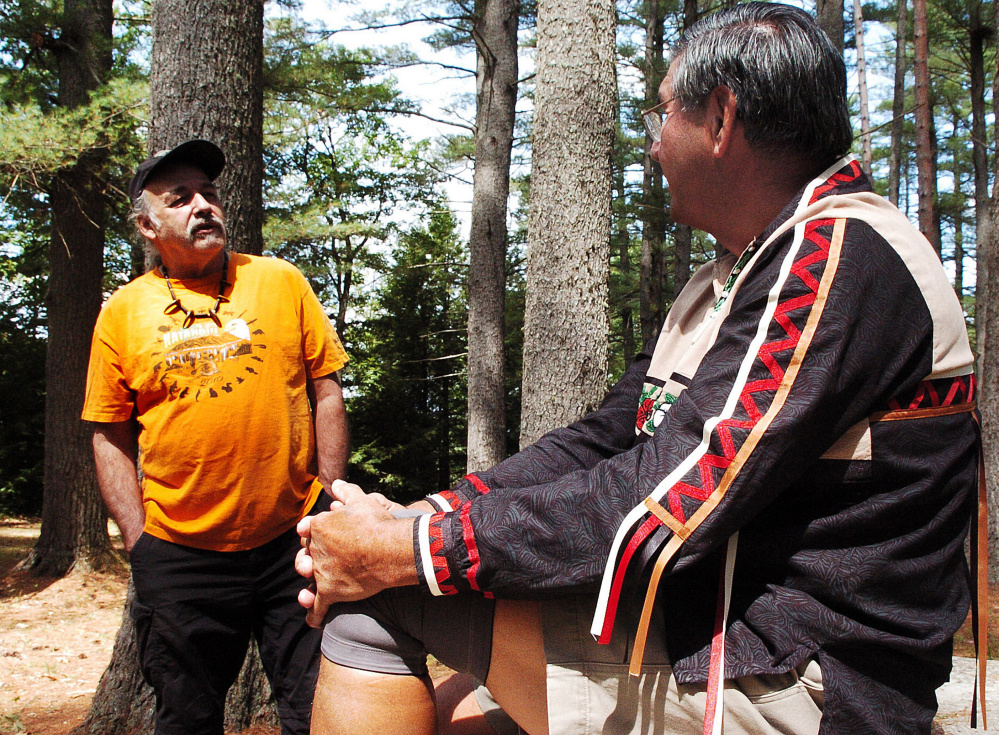MADISON — Whether it’s by canoe, on foot or in his pickup truck, Butch Phillips always returns to The Pines park each year for a special remembrance.
Phillips, 76, is a member of the Penobscot Nation whose ancestors were killed in an Aug. 22, 1724 massacre near the confluence of the Sandy and Kennebec rivers when British soldiers attacked an Abenaki Indian village in a fight to take over the land.
The surviving Abenaki fled, many of them going to live with the Penobscot or the Odanak Indians, and today that is how some of their descendants choose to return to the area where they were killed.
For about the last 20 years, members of the Wabanaki Confederacy, an alliance of five Native American nations including the Abenaki and the Penobscot, have returned to the site at The Pines to honor and remember their ancestors.
Few people know about the ceremony, but that could be starting to change. Phillips and other Native Americans said recently that today it is more important than ever to share their history and traditions with the outside world, especially in light of recent controversies such as the debate over whether to ban the use of the “Indians” nickname and mascot at Skowhegan Area High School.
The ceremony at The Pines, which doesn’t have a formal name, takes place around the same time that residents in Anson and Madison celebrate Madison Anson Days, originally known as Father Rasle Days, to remember the French missionary, Father Sebastian Rasle, who worked and lived with the Abenaki and was killed alongside them by the British.
For Native Americans who attend, it is a sacred day of coming together to worship their ancestors. In years past, the ceremony has typically drawn between 25 and 40 people, but on Sunday, Phillips, of Milford, was joined by just two others: Tom Obomsawin, a member of the Odanak tribe in Quebec, and Reggie Stanley of Pleasant Point, a member of the Passamaquoddy Tribe.
The three men remarked that the small group may be a sign of a loss of interest in their heritage and traditions by younger generations, or simply a matter of people being busy and a lack of communication, but either way they were there to keep the tradition going.
“It’s important to not forget,” said Obomsawin, 68, who has attended the ceremony in Madison for about the last 10 years. “We always honor and respect those that went before us.”
The ceremony was started by Phillips’ nephew Barry Dana of Solon during a “sacred run” from St. Francis, Quebec, to Indian Island prior to the annual Wabanaki Confederacy Conference. In the Native American tradition, running is seen as a sacred activity or form of prayer and among the Wabanaki has been used to carry embers from one conference location to another.
Dana said last week that it was by accident that he and a friend ended up at The Pines, but after seeing the name of the road where the park is located – Father Rasle Road – they knew they were in the spot where their ancestors had been killed.
“We wanted to run until sunup,” he said. “The idea was to get as far as we could, and it just happened to be sunup right at that site.”
Since then, Native Americans have been returning to the site each year at the end of August to honor their ancestors. Sometimes it’s on Aug. 22, the actual date of the massacre, but more often it’s on the closest weekend so more people can come.
Some years there have been overnight sacred runs from Old Town to Madison, and some years there have been shorter runs or canoe rides to get to the site.
“(During the massacre) survivors had to flee,” Dana said. “Many fled on foot and some by canoe, so we try and return in the same manner.”
They make a small fire and gather around as each says a prayer. Each person is given a handful of native medicine – sweet grass, tobacco, sage and cedar – to sprinkle on the flames.
The wing of an eagle – a sign of a mediator between Earth and the Great Spirit – is used to spread the smoke from the fire into the sky and carry the thoughts and meditations of those present to their ancestors.
When the ceremony is over, they often roast corn and enjoy a meal of traditional Native American foods such as salmon, baked beans and moose stew.
In the beginning, the ceremony was private and some parts still are, but increasingly the Native Americans on Sunday said it is important to share their tradition with the public.
The emphasis on education in part comes from the recent controversy over the use of the Indian mascot at Skowhegan Area High School, something that members of the Wabanaki have been trying to change for years but the idea has been met with resistance from some local residents.
In May 2015, the school board of Skowhegan-based School Administrative District 54 voted to keep the Indian mascot despite pleas to change it, and while sports teams and students continue to call themselves the “Indians,” there remains an ongoing effort to change the name.
The real history of the Abenaki people, including the 1724 massacre, “is not a good one,” according to Dana, and the mascot is a reminder of that.
“So many people don’t really have an idea of our culture,” Phillips said. “If they did, they would honor it. If we say something is offensive, who are they to argue against that? It really bothers us that people still think that way, so it’s a good idea to educate whenever we can.”
When it comes to the massacre of 1724, Phillips said he thinks few people in Maine know about what happened, or if they do, it’s not something they often remember or think about.
“The modern-day Wabanaki people still bear those scars,” he said. “We still remember and feel that pain.”
Send questions/comments to the editors.





Success. Please wait for the page to reload. If the page does not reload within 5 seconds, please refresh the page.
Enter your email and password to access comments.
Hi, to comment on stories you must . This profile is in addition to your subscription and website login.
Already have a commenting profile? .
Invalid username/password.
Please check your email to confirm and complete your registration.
Only subscribers are eligible to post comments. Please subscribe or login first for digital access. Here’s why.
Use the form below to reset your password. When you've submitted your account email, we will send an email with a reset code.